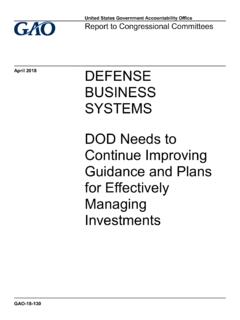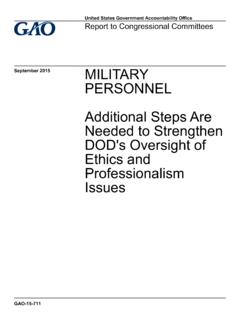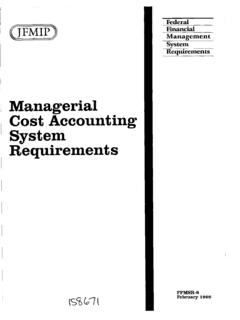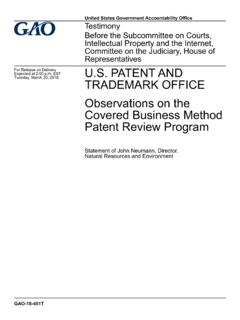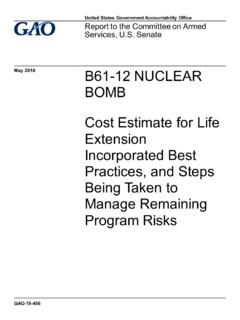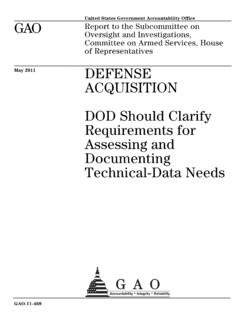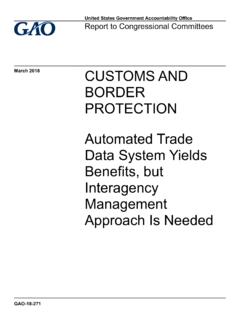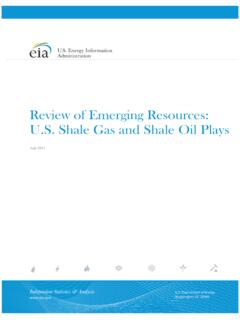Transcription of GAO-22-105111, Carbon Capture and Storage: Actions …
1 Carbon Capture AND STORAGE Actions Needed to Improve DOE Management of Demonstration Projects Report to Congressional Committees December 2021 GAO-22-105111 United States Government Accountability Office United States Government Accountability Office Highlights of GAO-22-105111, a report to congressional committees December 2021 Carbon Capture AND STORAGE Actions Needed to Improve DOE Management of Demonstration Projects What GAO Found The Department of energy s (DOE) investment of $ billion in Carbon Capture and storage (CCS) demonstration projects resulted in varying levels of success. Largely due to external factors that affected their economic viability, coal CCS projects were generally less successful than CCS projects at industrial facilities, such as chemical plants. Coal projects. DOE provided nearly $684 million to eight coal projects, resulting in one operational facility.
2 Three projects were withdrawn two prior to receiving funding and one was built and entered operations, but halted operations in 2020 due to changing economic conditions. DOE terminated funding agreements with the other four projects prior to construction. Project documentation indicated and DOE officials and project representatives told GAO that economic factors including decreased natural gas prices and uncertainty regarding Carbon markets negatively affected the economic viability of coal power plants and thus these projects. Industrial projects. DOE provided approximately $438 million to three projects designed to Capture and store Carbon from industrial facilities, two of which were constructed and entered operations. The third project was withdrawn when the facility onto which the project was to be incorporated was canceled. GAO identified significant risks to DOE s management of coal CCS demonstration projects.
3 These risks include the following: High-risk selection and negotiation processes. DOE s process for selecting coal projects and negotiating funding agreements increased the risks that DOE would fund projects unlikely to succeed. Specifically, DOE fully committed to coal projects at their initial selection as opposed to allowing time for further review, as it did for selected industrial CCS projects. Additionally, according to DOE officials, the department used expedited time frames for coal project negotiations less than 3 months as opposed to up to a year based on DOE s desire to begin spending American Recovery and Reinvestment Act of 2009 funds quickly. These Actions reduced DOE s ability to identify and mitigate technical and financial risks, a principle cited in DOE guidance. Bypassing of cost controls. DOE, at the direction of senior leadership, did not adhere to cost controls designed to limit its financial exposure on funding agreements for coal projects that DOE ultimately terminated.
4 As a result, the agency spent nearly $472 million on the definition and design of four unbuilt facilities almost $300 million more than planned for those project phases. According to DOE documentation and officials, senior leadership directed Actions to support projects even though they were not meeting required key milestones. DOE documentation also indicates that had Congress authorized an extension on the use of the funds, DOE might have continued funding some of these projects. By managing future CCS projects against established scopes, schedules, and budgets, DOE would be better positioned to mitigate its financial exposure if projects struggle. Additionally, absent a congressional mechanism to provide greater oversight and accountability such as requiring regular DOE reporting on project status and funding DOE may risk expending significant taxpayer funds on CCS demonstrations that have little likelihood of success.
5 View GAO-22-105111. For more information, contact Frank Rusco at (202) 512-3841 or Why GAO Did This Study Key scientific assessments have underscored the urgency of reducing emissions of Carbon dioxide (CO2), the most significant greenhouse gas, to help mitigate the negative effects of climate change. CCS technologies have the potential to reduce CO2 emissions from sources such as coal plants and industrial facilities. Since 2009, DOE has sought to establish the viability of CCS technologies through various demonstration projects. The 2021 Infrastructure Investment and Jobs Act authorized and appropriated billions of dollars in new investments in CCS demonstration projects. Congress included a provision in the energy Act of 2020 for GAO to review DOE s practices, successes, failures, and any improvements in executing CCS demonstration projects. This report examines (1) the outcomes of DOE-funded CCS demonstration projects and the factors that affected them and (2) DOE management of those projects.
6 GAO reviewed laws, regulations, guidance, funding agreements, and other project documentation, and interviewed DOE officials and project representatives. What GAO Recommends GAO is making one matter for congressional consideration: that Congress consider implementing a mechanism for greater oversight and accountability of DOE CCS demonstration project funding. GAO is recommending that DOE (1) improve its project selection and negotiation processes and (2) more consistently administer projects against established, scopes, schedules, and budgets. DOE neither agreed nor disagreed with the recommendations. Page i GAO-22-105111 Carbon Capture and Storage Letter 1 Background 3 Coal CCS Projects Were Less Successful Than Industrial CCS Projects, Largely Due To Economic Factors 7 DOE s Management of Coal CCS Demonstration Projects Created Significant Risks to Project Success and Taxpayer Funds 15 Conclusions 23 Matter for Congressional Consideration 25 Recommendations for Executive Action 25 Agency Comments 25 Appendix I Comments from the Department of energy 27 Appendix II GAO Contact and Staff Acknowledgments 28 Tables Table 1: Coal Carbon Capture and Storage Demonstration Project Outcomes, Final Phase, and Department of energy (DOE) Funding 7 Table 2: Industrial Carbon Capture and Storage Demonstration Project Outcomes, Final Phase, and Department of energy (DOE) Funding 11 Table 3.
7 Department of energy (DOE) Funding for Coal Carbon Capture and Storage Projects Whose Cooperative Agreements DOE Ultimately Terminated 19 Contents Page ii GAO-22-105111 Carbon Capture and Storage Abbreviations CCS Carbon Capture and storage CO2 Carbon dioxide DOE Department of energy Recovery Act American Recovery and Reinvestment Act of 2009 This is a work of the government and is not subject to copyright protection in the United States. The published product may be reproduced and distributed in its entirety without further permission from GAO. However, because this work may contain copyrighted images or other material, permission from the copyright holder may be necessary if you wish to reproduce this material separately. Page 1 GAO-22-105111 Carbon Capture and Storage 441 G St. Washington, DC 20548 December 20, 2021 The Honorable Joe Manchin III Chairman The Honorable John Barrasso Ranking Member Committee on energy and natural Resources United States Senate The Honorable Eddie Bernice Johnson Chairwoman The Honorable Frank Lucas Ranking Member Committee on Science, Space, and Technology House of Representatives Key scientific assessments have underscored the urgency of reducing emissions of Carbon dioxide (CO2), the most significant greenhouse gas, to help mitigate the negative effects of climate change.
8 Among the strategies being developed to reduce CO2 emissions is Carbon Capture and storage (CCS), a process that involves capturing CO2 generated by human activities at its source for example, coal-fired power plants and industrial facilities and storing it permanently underground in geologic formations, such as depleted oil and gas Captured CO2 can also be used to enhance oil recovery, and research is ongoing regarding its use in other industrial processes. Reflecting CCS s potential as a strategy to reduce CO2 emissions, the 2021 Infrastructure Investment and Jobs Act authorized and appropriated more than $ billion over fiscal years 2022 through 2025 for Carbon Capture demonstration Nevertheless, implementing CCS technologies has proven to be a challenge in the past, particularly when factoring in the economic viability of building new facilities or retrofitting existing ones in order to Capture CO2.
9 Beginning in 2009, DOE initiated numerous efforts to accelerate the development of CCS technologies. Among these, DOE initiated projects to demonstrate the feasibility of CCS technologies at commercial scale at 1 CCS is sometimes referred to as CCUS Carbon Capture , utilization, and storage. In addition, CCS is also sometimes referred to as Carbon Capture and sequestration. 2 The energy Act of 2020 also authorized $ billion for DOE to award for six CCS demonstration projects through 2025. Letter Page 2 GAO-22-105111 Carbon Capture and Storage both coal-powered electricity generation plants and industrial facilities. As we reported in September 2018, DOE spent approximately $ billion on nine large CCS demonstration projects from 2010 through 2017 six coal and three industrial through cooperative agreements in which DOE shares a portion of project costs along with funding recipients, which are responsible for the In light of past and potential future federal government investments in CCS technologies, the energy Act of 2020 included a provision for GAO to report on the successes, failures, practices, and improvements in DOE s administration of large CCS demonstration This report examines (1) the outcomes of past DOE-funded CCS demonstration projects and the external factors that affected them and (2) how DOE s management of these projects contributed to their outcomes.
10 We focused our review on the nine large CCS demonstration projects that received DOE funding beginning in 2009. To address both objectives, for each project, we reviewed project documentation that describes project goals, expected budgets and schedules, actual budgets and schedules, and outcomes. This documentation included related legislation, funding opportunity announcements, DOE project selection announcements, cooperative agreements and modifications, and project technical reports. We analyzed these documents to identify project outcomes and the external factors that contributed to them, which we discussed with DOE officials and project Additionally, we reviewed DOE guidance as well as internal control standards and assessed DOE s Actions in managing CCS demonstration projects against these We also interviewed DOE officials and project representatives to obtain their perspectives on Actions that DOE 3 DOE selected 11 projects, but two withdrew prior to receiving funding.


